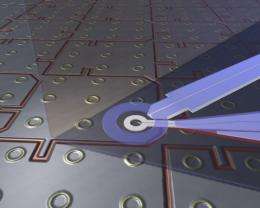April 28, 2009 feature
Study of 'Persistent Currents' Finally Verifies Theory

(PhysOrg.com) -- Approximately 20 years ago, scientists discovered that is is possible for an electric current to flow endlessly in a ring made of a normal metal. One might think that such an 'old' finding would be well understood and no longer interesting to today's researchers, but scientists are still studying the phenomenon.
In a recent and particularly successful example of this, researchers from Stanford University and the University of Colorado, Denver, completed an experiment that confirms the physics theory regarding the behavior of persistent currents in rings made of normal (not superconducting) metal.
The study’s lead researcher, Stanford physicist Kathryn Moler, told PhysOrg.com, “I began thinking about this experiment even before I joined the Stanford faculty in 1997. It took a long time to get the apparatus to be sensitive enough to detect the currents because they are so small.”
The group’s work marks the first time that the theory has been experimentally proven to a high degree.
“Persistent currents have fascinated physicists for decades,” added co-researcher Hendrik Bluhm, currently a postdoctoral scientist at Harvard University. “But the quantitative experimental verification of this phenomenon has remained elusive because of the difficulty of detecting, without disturbing the effect, the tiny current that corresponds to a single electron traveling around the ring.
“Our study of more than thirty individual rings, in which we employed a scanning technique to overcome some of these challenges, shows good agreement with theoretical expectations.”
The rings are very small, each only between one and two micrometers (millionths of a meter) in diameter and 140 nanometers (billionths of a meter) thick. They are made of high-purity gold. Each was scanned individually, unlike past experiments on persistent currents conducted by other groups. In total they were scanned approximately 10 million times.
The scanning device is a SQUID microscope. A SQUID, or superconducting quantum interference device, can detect extremely small magnetic fields like those produced by the circulating currents in the rings.
The physics theory behind persistent currents in normal metal rings states, in part, that the persistent current is a periodic function, or a repeating pattern, of the applied magnetic field. The direction of the current as well as its amplitude vary from ring to ring because the rings are not identical.
The theory also predicts that the currents should decrease in size as the temperature of the rings increases.
Bluhm and his colleagues were able to experimentally verify both parts of the theory. When they created a graphical representation of the amplitudes of the flux as measured using the SQUID microscope, the resulting picture was a close match to what theory predicts they should see. How the amplitudes were affected by the temperature of the rings also agrees well with theoretical predictions, at least within the limited temperature range they worked in.
This research is published in the March 30, 2009, online edition of Physical Review Letters.
More information: Phys. Rev. Lett. 102, 136802 (2009)
Copyright 2009 PhysOrg.com.
All rights reserved. This material may not be published, broadcast, rewritten or redistributed in whole or part without the express written permission of PhysOrg.com.

















